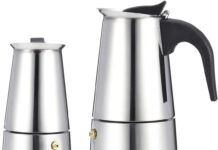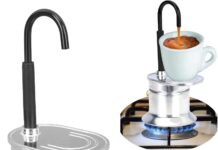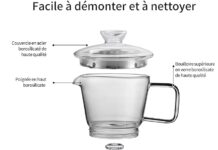If you’re a coffee lover like us, you’ve probably wondered if it’s possible to create your favorite latte or cappuccino using a Bialetti. Well, we’ve got exciting news for you! In this article, we’ll explore the world of Bialetti coffee makers and see just how versatile they can truly be. So grab a cup of your favorite brew and join us as we dive into the wonderful possibilities that await you with a Bialetti.
What is a Bialetti?
Definition of Bialetti
A Bialetti is a brand of stovetop or electric coffee maker that is renowned for its ability to make rich and flavorful coffee. The Bialetti coffee makers are designed to brew espresso-style coffee, which can be used as the base for a variety of specialty coffee drinks, including lattes and cappuccinos. With their distinctive shape and iconic design, Bialetti coffee makers have become a staple in many homes and coffee shops around the world.
How a Bialetti works
The Bialetti coffee maker, also known as a Moka pot, works by using steam pressure to brew coffee. The pot consists of three chambers: a bottom chamber for water, a middle chamber for ground coffee, and a top chamber for the brewed coffee. As the water in the bottom chamber heats up on the stovetop or through an electric heating element, steam is created, which then passes through the middle chamber containing the coffee grounds. The steam pressure forces the water through the coffee grounds and up into the top chamber, resulting in a rich and concentrated espresso-style coffee.
Understanding Latte and Cappuccino
What is a latte?
A latte is a popular espresso-based drink that combines a shot of espresso with steamed milk and a small amount of foam on top. It is known for its smooth and creamy texture and is often enjoyed with added flavors such as vanilla or caramel. The word “latte” actually means milk in Italian, which signifies the importance of the milk component in this drink.
Ingredients of a latte
To make a latte, you will need the following ingredients:
- Espresso: A strong and concentrated coffee made using a Bialetti or any other espresso machine.
- Milk: Whole milk is commonly used for a creamier texture, but you can use any type of milk depending on your preference.
- Sweetener (optional): Sugar, honey, or flavored syrups can be added for a touch of sweetness and extra flavoring.
- Flavorings (optional): Vanilla, caramel, or other flavored syrups can be used to enhance the taste of your latte.
- Foam (optional): Extra frothed milk can be added on top of the latte for a more luxurious and visually appealing presentation.
What is a cappuccino?
A cappuccino is another popular espresso-based drink that originated in Italy. It consists of equal parts espresso, steamed milk, and milk foam. The foam adds a velvety texture to the drink and serves as a layer of insulation to keep the coffee hot. Cappuccinos are often enjoyed in the morning and are known for their balanced flavor profile.
Ingredients of a cappuccino
To make a cappuccino, you will need the following ingredients:
- Espresso: A shot of strong and concentrated coffee made using a Bialetti or any other espresso machine.
- Milk: Whole milk is traditionally used for cappuccinos, as it produces a thicker and creamier foam.
- Foam: The top layer of the milk, which can be created using a steam wand or a Bialetti frothing method.
- Chocolate powder or cinnamon (optional): Some variations of cappuccino include a sprinkle of chocolate powder or cinnamon on top for added flavor.
Types of Bialetti
Stovetop Bialetti
The stovetop Bialetti is the classic and most widely recognized type of Bialetti coffee maker. It is made of durable aluminum or stainless steel and is designed to be used on the stovetop to heat the water and brew the coffee. Stovetop Bialetti coffee makers come in various sizes, allowing you to choose the one that best suits your needs and the number of cups of coffee you want to make. They are easy to use and maintain, making them a popular choice for coffee enthusiasts who appreciate the art of traditional coffee brewing.
Electric Bialetti
The electric Bialetti is a more modern version of the classic stovetop Bialetti. It operates using an electric heating element instead of the stovetop, which provides more control over the brewing process and eliminates the need for a separate heat source. Electric Bialetti coffee makers often come with additional features, such as programmable functions and automatic shut-off timers, making them convenient and user-friendly. They are a great option for those who prefer the ease and convenience of electric appliances in their coffee-making routine.
Making Latte with a Bialetti
Step-by-step guide
- Fill the bottom chamber of your Bialetti coffee maker with water up to the indicated level.
- Insert the middle chamber filled with finely ground coffee into the bottom chamber.
- Screw on the top chamber tightly to ensure a proper seal.
- Place the Bialetti coffee maker on the stovetop or turn on the electric Bialetti, following the manufacturer’s instructions.
- Heat the Bialetti until the coffee starts to brew, and steam begins to rise.
- While the coffee is brewing, froth the desired amount of milk using the Bialetti frothing method or any alternative method mentioned in this article.
- Once the coffee is brewed, pour it into a cup, leaving some space for the frothed milk.
- Slowly pour the frothed milk into the cup, aiming for a layered effect of coffee and milk.
- If desired, add any sweeteners or flavorings to taste.
- Enjoy your homemade latte!
Recommended coffee-to-milk ratio
The recommended coffee-to-milk ratio for a latte is usually 1:3 or 1:4. This means that for every 1 part of espresso, you should use 3 or 4 parts of milk. However, the ratio can be adjusted based on personal preference. If you prefer a stronger coffee flavor, you can increase the amount of espresso, and if you prefer a milkier taste, you can increase the amount of milk.
Tips for frothing milk with a Bialetti
- Choose the right type of milk: Whole milk works best for frothing as it produces a thicker and creamier foam, but you can experiment with different types of milk to find your preferred texture and taste.
- Warm the milk slightly before frothing: This helps to achieve a smoother and silkier texture in the frothed milk.
- Use a frothing pitcher: A dedicated frothing pitcher with a spout makes it easier to pour the frothed milk into your latte.
- Keep the frothing wand near the surface of the milk: This allows more air to be incorporated into the milk and creates a frothier texture.
Making Cappuccino with a Bialetti
Step-by-step guide
- Follow steps 1-5 of the latte-making process mentioned earlier to brew a shot of espresso using your Bialetti coffee maker.
- While the coffee is brewing, froth the desired amount of milk using the Bialetti frothing method or any alternative method mentioned in this article.
- Once the coffee is brewed, pour it into a cup.
- Pour the frothed milk into the cup, aiming to fill one-third of the cup.
- Spoon a layer of milk foam on top of the milk.
- If desired, sprinkle chocolate powder or cinnamon on top for added flavor.
- Your homemade cappuccino is ready to be enjoyed!
Recommended coffee-to-milk ratio
The recommended coffee-to-milk ratio for a cappuccino is usually 1:1:1, which means equal parts of espresso, steamed milk, and foam. This ratio ensures a balanced flavor profile where none of the components overpower the other. However, feel free to adjust the ratio according to your personal taste preferences.
Tips for frothing milk with a Bialetti
- Follow the same tips mentioned earlier for frothing milk with a Bialetti when making a latte.
- Aim for a thick and velvety foam: Cappuccinos are known for their thick layer of foam on top, so make sure to froth the milk until it reaches the desired texture.
- Use a thermometer: If you prefer to have precise control over the temperature of your milk, consider using a milk frothing thermometer to ensure it reaches the ideal temperature range of 140°F to 160°F (60°C to 70°C).
Alternative Methods for Frothing Milk
Using a milk frother
Milk frothers are standalone devices specifically designed to froth milk. They come in various types, including handheld frothers, electric frothers, and steam wand frothers. These devices provide quick and convenient frothing options, allowing you to achieve perfectly frothed milk for your lattes and cappuccinos. Simply pour the milk into the frother, press a button or activate the wand, and wait for the milk to froth. Once frothed, pour it into your coffee and enjoy!
Steam wand on an espresso machine
If you own an espresso machine with a built-in steam wand, you can use it to froth milk for your lattes and cappuccinos. The steam wand works by emitting steam at high pressure, creating a creamy and frothy texture in the milk. To froth milk using a steam wand, follow these steps:
- Fill a metal pitcher with the desired amount of milk.
- Place the steam wand into the milk, just below the surface.
- Open the steam valve to release steam into the milk.
- Position the pitcher at an angle and move it in a circular motion to create a whirlpool effect.
- Continue frothing until the milk reaches the desired temperature and texture.
Hand frothing with a whisk
For those without specialized equipment, you can still achieve frothy milk by hand using a whisk. Although it requires a bit more effort, it can be a fun and rewarding way to froth milk for your homemade lattes and cappuccinos. Here’s how you can do it:
- Pour the desired amount of milk into a metal pitcher.
- Heat the milk gently on the stovetop or in the microwave until it reaches a warm temperature.
- Hold the handle of the whisk between your palms and rub your hands together rapidly to create friction and generate heat.
- Place the whisk into the milk and vigorously whisk it back and forth, using a rapid up-and-down motion.
- Continue whisking until the milk becomes frothy and increases in volume.
- Remove any large bubbles by tapping the pitcher gently on a flat surface.
- Pour the frothed milk into your coffee and enjoy!
Choosing the Right Coffee
Quality of coffee beans
When making specialty coffee drinks, the quality of your coffee beans plays a crucial role in the final taste and aroma. It is recommended to use freshly roasted coffee beans for the best flavor. Look for beans that are labeled as “espresso blend,” as they are specifically formulated for brewing espresso-style coffee, which forms the base of lattes and cappuccinos.
Ground coffee vs. whole beans
To achieve the freshest and most flavorful coffee, it is generally recommended to grind your coffee beans just before brewing. This ensures that the flavors and aromas are preserved until they come into contact with water. However, if you prefer convenience or do not have a grinder, you can purchase pre-ground coffee that is labeled for espresso or espresso-style brewing. Just make sure to store it properly in an airtight container to maintain freshness.
Roast level
The roast level of coffee beans can greatly influence the taste of your lattes and cappuccinos. Different roast levels, such as light, medium, and dark, offer distinct flavor profiles. Light roasts tend to have brighter and more delicate flavors, while dark roasts have a bolder and more robust taste. Medium roasts strike a balance between the two. Experiment with different roast levels to find the one that suits your personal preference and complements the flavors of your specialty coffee drinks.
Cleaning and Maintaining a Bialetti
Cleaning the pot
Regular cleaning is essential to maintain the performance and longevity of your Bialetti coffee maker. Here’s how to clean the pot:
- Wait for the pot to cool down completely before handling.
- Disassemble the pot by unscrewing the top and separating the chambers.
- Empty the used coffee grounds from the middle chamber and rinse it with warm water.
- Use a soft brush or cloth to clean the inside and outside of the pot.
- Rinse all the parts thoroughly with warm water to remove any residual coffee grounds or soap.
- Allow the parts to air dry before reassembling the pot.
Descaling
Over time, mineral deposits from the water can build up inside the Bialetti coffee maker, affecting its performance and the taste of your coffee. Descaling helps remove these deposits and keep the pot functioning optimally. To descale your Bialetti:
- Fill the bottom chamber with equal parts of water and white vinegar.
- Assemble the pot and place it on the stovetop or turn on the electric Bialetti.
- Bring the mixture to a boil and let it simmer for a few minutes.
- Turn off the heat and allow the pot to cool down.
- Empty the vinegar-water mixture and rinse the pot thoroughly with clean water.
- Repeat the rinsing process a few times to ensure all traces of vinegar are removed.
Replacing parts
With regular use, certain parts of your Bialetti coffee maker may need to be replaced. Common replacement parts include gaskets, filter plates, and handles. It is important to use genuine Bialetti replacement parts to ensure a proper fit and maintain the quality of your coffee maker. Replacement parts can be purchased directly from the Bialetti website or from authorized retailers.
Frequently Asked Questions (FAQs)
Can I use pre-ground coffee?
Yes, you can use pre-ground coffee in your Bialetti coffee maker. Look for coffee that is specifically labeled for espresso or espresso-style brewing. Just keep in mind that pre-ground coffee may not be as fresh as grinding your own beans, so it may slightly affect the taste and aroma of your coffee.
What type of milk should I use?
The type of milk you use depends on personal preference. Whole milk is commonly used for its creamy and rich texture, but you can choose from a variety of milk options, such as skim milk, 2% milk, almond milk, soy milk, or oat milk. Experiment with different types of milk to find the one that suits your taste and dietary preferences.
How long does it take to make a latte or cappuccino with a Bialetti?
The time it takes to make a latte or cappuccino with a Bialetti depends on various factors, including the size of the Bialetti coffee maker, the heat source, and the desired strength of the coffee. On average, it takes around 5-10 minutes for the Bialetti to heat up and brew the coffee. Frothing the milk can take an additional 2-5 minutes, depending on the method used. Overall, the process can take anywhere between 7-15 minutes, but it is worth the wait for a delicious and satisfying cup of specialty coffee.
Conclusion
In conclusion, making lattes and cappuccinos with a Bialetti coffee maker is not only possible but also a delightful and rewarding experience. Whether you opt for the classic stovetop Bialetti or the more modern electric version, you can enjoy rich and flavorful coffee from the comfort of your own home. By following the step-by-step guides and utilizing alternative methods for frothing milk, you can create delicious specialty coffee drinks that rival those from your favorite coffee shop. Consider the type of coffee, the right coffee-to-milk ratio, and the maintenance of your Bialetti to ensure the best possible results. So go ahead, unleash your inner barista, and enjoy the magic of a homemade latte or cappuccino with a Bialetti coffee maker!





































